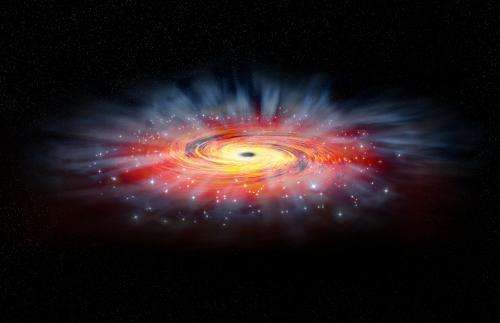Astronomers discover why supermassive black holes consume less material than expected

Using NASA's super-sensitive Chandra X-ray space telescope, a team of astronomers led by Q. Daniel Wang at the University of Massachusetts Amherst has solved a long-standing mystery about why most super massive black holes (SMBH) at the centers of galaxies have such a low accretion rate—that is, they swallow very little of the cosmic gases available and instead act as if they are on a severe diet.
"In principle, super massive black holes suck in everything," Wang says, "but we found this is not correct." Astronomers once thought SMBHs with their intense gravitational pull indiscriminately devoured all sorts of stars, dust and other matter in epic amounts. But in recent years, using X-ray emissions as a measure of heat given off by powerful gravitational forces, they unexpectedly found that most SMBH accrete matter at very low levels.
In fact, SMBHs' signature X-ray emissions, which come from an area much larger than the black holes themselves, are often so surprisingly faint that the objects are difficult to distinguish from their galaxy centers. "There has been a big mystery about why most of these black hole signals are so faint," says Wang, an expert in deep space X-ray analysis.
Now, taking advantage of very long observation times with the Chandra instrument and their detailed knowledge of the nearest SMBH, Sagittarius A* (Sgt A*), about 26,000 light years away at the center of our own Milky Way galaxy, he and an international team of astronomers tested the leading accretion models. For the first time, they were able to pinpoint and discriminate among X-ray sources near Sgt A* and identify exactly what the SMBH is feeding on. The advance is described in the current issue of Science.
To explain the faint X-ray signals, some astronomers had theorized that emissions from regions around SMBH had nothing to do with the black hole itself but rather with concentrations of low-mass stars associated with SMBHs. Wang adds, "There are also a huge number of young, massive stars as well as low-mass stars near these SMBHs, so it's very crowded in the downtown area of the galaxy. Hard to tell what was going on."

"The massive stars have extremely high winds associated with them and the winds are colliding and swirling at very high speeds, which make the gases in this environment very hot. We found that first, the SMBH has difficulty in accreting such gases. Second, the gases are too hot for the black hole to swallow. Instead it rejects about 99 percent of this super hot material, only letting a small amount in. This makes sense because the hotter the gases, the more difficult it is for the black hole to pull them in."
A diet of cooler gases would accrete in a more orderly fashion, but the SMBH's sphere of influence and its ability to accrete or draw in new material both decrease with increasing gas temperatures, he points out.
Wang, who did this NASA-supported work while on four-month sabbatical as a Raymond and Beverly Sackler Distinguished Visiting astronomer at the University of Cambridge, U.K., points out, "Now we have physically resolved it and for the first time we've made the connection observationally between the massive stars moving around black holes and the X-ray emitting material. We can definitively rule out that these X-rays are coming from a concentration of low-mass stars. We don't see the expected energy signature predicted by that scenario."
The astronomers not only detected the X-ray source, he adds, but for the first time can describe its shape, which is elongated. "Now we know what kind of material is getting into the black hole, though exactly how it happens is still another question."
Others on the international team with Wang are from the University of Cambridge and University of Leicester, U.K.; Massachusetts Institute of Technology; University of Amsterdam; Chinese Academy of Sciences; Universidad Católica de Chile; University of California Berkeley; Université de Strasbourg; Centre National de la Recherche Scientifique, Paris; Northwestern University; Nanjing University; Boston University and the University of Maryland, College Park.
The center of our own galaxy offered the team an excellent lab for studying such questions because, as Wang says, "we know the kind of stars that are here in our own downtown." Another strength of this study, the Chandra instrument, provides improved spectral resolving power, he adds. In addition the researchers enjoyed unprecedented observation time of 3 megaseconds, almost five weeks, with the Chandra X-ray Observatory.
"We needed that long because the target is so faint, we need enough strength of signal to process the data to concentrate on such quiescent emissions and to get the signatures identified firmly."
More information: "Dissecting X-Ray–Emitting Gas Around the Center of Our Galaxy," by Q.D. Wang et al Science, 2013. On Arxiv: arxiv.org/abs/1307.5845
Journal information: Science
Provided by University of Massachusetts Amherst




















